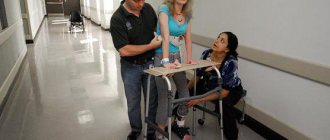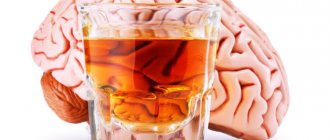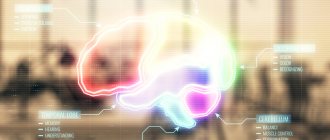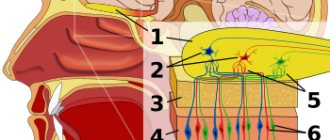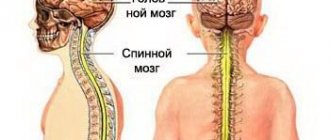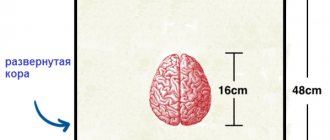Causes of meningoencephalitis
Depending on the method of occurrence, meningoencephalitis is divided into two types:
- Primary
is an independent disease. Most often occurs after an encephalitis tick bite. - Secondary
– as a complication of an existing disease.
With the development of primary meningoencephalitis, the infection enters the blood and spreads throughout the body, affecting the tissue of the brain and its membranes.
The secondary type of disease occurs when the immune system is weakened due to the presence of infection in the body. This type is most dangerous for people with weak immune systems, children and the elderly.
The main reasons for the development of secondary encephalitic meningitis:
- autoimmune diseases;
- herpes;
- mumps;
- angina;
- piggy;
- sinusitis;
- sinusitis;
- otitis;
- periodontal disease.
In rare cases, allergies to medications that lower the body’s immunity and vaccinations contribute to the occurrence of the disease.
Attention!
This type of disease is characterized by rapid development and often leads to the death of the patient.
In addition, meningitis itself, in severe cases, causes the encephalitis form.
With this type of development, inflammation, initially localized in the brain tissue, spreads and affects the meninges. This type is considered secondary encephalitic meningitis caused by encephalitis.
Treatment of amoebic meningitis
Therapy for primary amoebic meningitis in 90% of cases does not lead to good results. The reasons for this are the difficulty of identifying the causative agent of the pathology and the patient’s delay in seeking medical help.
The patient is immediately sent by ambulance to the intensive care unit, where a group of specialists provides competent therapy and constantly monitors changes in his condition.
Since the causative agent of the disease is bacteria, intravenous antibiotics are prescribed first to eliminate the cause of the patient’s painful condition:
- Amphotericin B;
- Rifampicin;
- Tetracycline;
- Artemisinin B;
- Metronidazole.
Depending on the patient’s condition, one of the drugs is chosen or therapy is carried out with several at once; the combination is prescribed by a neurologist. Injections are given every 4-5 hours, the dosage is chosen by the doctor individually.
Injection solutions are administered not only through a vein, but also directly under the membranes of the brain. Usually, they first prevent the development of amoebas throughout the body and administer drugs intravenously, then move on to the immediate foci of inflammation. Thus, the likelihood of eliminating protozoa from the area of vital organs increases.
Sometimes antifungal solutions are used for intramuscular administration.
Along with antibiotics, it is necessary to take vitamin complexes. B vitamins are often prescribed, since they are responsible for the normal condition and restoration of the central and autonomic nervous system.
To relieve symptoms, the following groups of medications are used:
- anti-inflammatory;
- antispasmodic;
- angioprotectors.
Medicines are administered intravenously. Intramuscular or oral administration.
Ulcers on the skin must be treated with antibiotic-based ointments and gels.
After the risk of death has been eliminated, the patient is transferred from intensive care to the general care ward. Here it is necessary to create conditions for his recovery. First of all, remove irritants: there should be dim light in the room. He is prescribed bed rest for at least 7 days. The sick person must be provided with plenty of sweet drinks and dietary nutrition. Products should be chosen steamed or boiled, with low fat content. To do this, it is better to choose vegetables and fruits.
Medication therapy continues, usually intramuscular injections and tablets are used.
Further recovery comes down to physiotherapeutic procedures:
- electrophoresis;
- reflexology;
- mud therapy;
- UHF;
- magnetotherapy.
Regular exercise therapy and massages are carried out. Recovery sometimes takes 3-4 months.
How is this meningitis transmitted?
Infection with encephalitic meningitis occurs in two main ways:
- When bitten by an encephalitis tick. The tick acts as a carrier of infection that causes inflammation of the brain. This insect is most often found in the northern part of Russia and Siberia.
- When consuming milk that has not undergone heat treatment from an animal bitten by such a tick.
These methods are typical only for the development of primary meningoencephalitis. Secondary always occurs as a complication of infectious diseases when the body’s immunity decreases.
The most dangerous are inflammatory processes of a purulent nature.
In severe cases of influenza, measles, rubella, and inflammation of the nasopharynx, there is a risk of damage to the brain and its membranes.
Depending on the individual characteristics of the patient, the incubation period lasts from one day to a month and is usually 5–14 days. At this time, pathogenic agents multiply and penetrate the tissues.
Stages of the disease
During meningoencephalitis, the beginning (the appearance of the first signs), the height and the outcome are distinguished. Infectious types of disease also have a prodromal, or latent (latent) stage, which can be asymptomatic or have minor and nonspecific clinical manifestations. Latent period, i.e.
the time from infection to the appearance of the first signs of the disease can last from several hours to several months, depending on the etiology. The height of the disease is characterized by severe and progressive symptoms. The outcome can be recovery or death if brain damage reaches a critical level and affects vital centers.
Some types of disease have stages that are characteristic of them. For example, during meningoencephalitis, three periods are distinguished: the precursor stage (corresponding to the prodromal stage), the stage of excitation, and the stage of paralysis.
Symptoms
The encephalitic form of meningitis combines the symptoms of both meningitis and encephalitis:
- increased fatigue;
- headache;
- chills;
- loss of appetite;
- muscle pain;
- disturbances of smell, vision and hearing.
Symptoms vary depending on which part of the brain is affected
. So the patient experiences cerebral palsy, difficulty breathing, attention problems, and hallucinations. This makes it very difficult for a doctor to diagnose a serious disease.
Symptoms of meningitis:
- an increase in temperature that is not controlled by antipyretics;
- positive reaction to Kernig and Brudzinsky tests;
- muscle stiffness in the back of the neck and back;
- headache;
- dizziness;
- vomiting and diarrhea.
In the initial stages, symptoms are mild. In the later stages, a severe cough and runny nose appear. The disease manifests itself with general cerebral signs of encephalitis. With further development of the disease, meningeal symptoms are added.
Important!
If you notice these symptoms, consult your doctor immediately. With timely treatment, the chances of recovery without complications are high.
Symptoms in adults
The general clinical picture of meningoencephalitis is characterized by a combination of general infectious, meningeal, liquor-hypertensive symptoms. Characteristic signs of all types of disease are:
- increase in body temperature to 39-40°C;
- intense headache;
- nausea, vomiting;
- loss of appetite;
- apathy;
- increased fatigue;
- chills;
- clouding of consciousness;
- increased blood and intracranial pressure;
- extreme agitation or drowsiness;
- violation of orientation in space;
- impaired coordination of movements;
- tachycardia (rapid heartbeat);
- dyspnea;
- skin rash;
- increased sensitivity to light and sound;
- convulsions;
- vestibular ataxia (impaired coordination of movements);
- pale skin;
- asymmetry of tendon reflexes;
- drooping upper eyelid;
- the appearance of facial asymmetry;
- swallowing disorder.
How to diagnose the encephalitic form of the disease?
The main analysis is a study of cerebrospinal fluid.
For this purpose, a puncture is made in the membranes of the spinal cord and fluid is collected. This procedure not only allows you to determine the presence of inflammation and identify the causative agent of the infection, but also reduces intracranial pressure.
In addition, when collecting cerebrospinal fluid, attention is paid to its pressure in the spinal cord canal. An increase in pressure indicates an increase in intracranial pressure, which is a sign of encephalitic meningitis.
A general blood test is also performed. An increase in the number of lymphocytes signals an inflammatory process in the body.
Features of treatment
Diagnosis is made using a spinal tap. The membrane of the spinal cord is punctured and fluid is withdrawn. The pressure at which the liquid appears outside is important. If the indicator is high, then this indicates the presence of the disease. The analysis determines the causative agent of the disease, as well as the infectious process.
By drawing fluid, intracranial pressure is reduced, which alleviates symptoms. After passing the examination, an effective treatment method is determined. Doctors prescribe medications necessary to eliminate inflammation, suppress infection, and strengthen the immune system:
- antibiotics;
- antiviral drugs;
- antifungal and antihistamine medications.
Sometimes antihistamines are chosen. Symptomatic recovery is prescribed for each patient individually, since everyone’s disease progresses differently. Rehabilitation lasts quite a long time, everything is determined by the degree of the disease. Neuroprotectors, antioxidants, and means to improve blood circulation can be used. Vitamins B and E and medications with a calming effect are needed.
In addition to drug treatment, physiotherapy and reflexology are used. It is important for all people who have had meningoencephalitis to visit a neurologist. This will allow you to monitor your health, as well as consult on compliance with preventive measures. Spa treatment helps.
Consequences and complications
This type of meningitis is a dangerous disease, after which the patient is always assigned a disability. Unfortunately, it is impossible to cure it without consequences. With timely treatment, there is only a chance to minimize complications.
Complications are most pronounced in people with weakened immune systems, children and the elderly.
Encephalitic meningitis leads to the following consequences:
- Memory and attention disorders.
- Mental disorders up to the development of psychosis.
- Personality disorders.
- Epilepsy.
- Deterioration of vision and hearing.
When seeking help late and when it is severe, it often leads to the death of the patient.
Notes
- Naegleria fowleri - Primary Amebic Meningoencephalitis (PAM) - Treatment (English). US Centers for Disease Control and Prevention.
- Baig AM, Kulsoom H, Khan NA (May 2014). "Primary amoebic meningoencephalitis: amoebicidal effects of clinically approved drugs against Naegleria fowleri." Journal of medical microbiology 63
(5): 760-762. DOI:10.1099/jmm.0.072306-0. - Kim JH, Jung SY, Lee YJ, Song KJ, Kwon D, Kim K, Park S, Im KI, Shin HJ (September 2008). "Effect of therapeutic chemical agents in vitro and on experimental meningoencephalitis due to Naegleria fowleri". Antimicrobial agents and chemotherapy 52
(11): 4010-4016. DOI:10.1128/AAC.00197-08.
How to protect yourself and your loved ones?
Prevention of the disease is carried out in three directions:
- prevention of infection;
- preventing tick bites;
- increasing immunity.
To prevent infection, vaccination is carried out. The effect of the drug lasts four years. Therefore, there is a need for repeated vaccination. To avoid being bitten by a tick, wear closed clothing, high shoes and a hat when visiting forests.
Also, after returning home, carefully inspect your clothes. This will help you find the tick before it bites. To improve immunity, it is recommended to take vitamins, eat right, and lead an active lifestyle. To reduce the risk of secondary meningoencephalitis by specialists of the site or ask your question, you can do it completely free of charge
in comments.
And if you have a question that goes beyond the scope of this topic, use the Ask a question
higher.
Encephalitic meningitis is a severe disease that can be transmitted through the bite of ticks (mainly ixodid ticks). Meningococcal encephalitis especially often affects children, often leading to disability or even death.
Unfortunately, even successful treatment of this form of meningitis often leaves the patient disabled for life. The consequences of meningoencephalitis can be so severe that the patient requires help from outsiders for the rest of his life.
The infectious disease meningoencephalitis is an extremely serious condition characterized by inflammation of the membranes of the brain and its substance. In this case, encephalitic meningitis can develop due to both bacterial and viral pathogens.
Meningitis encephalitis in children (in them it is most often observed) has a severe course and an unfavorable prognosis (most children die even with massive therapy).
Encephalitic meningitis is often observed from birth, but also occurs in adulthood. Treatment for meningitis needs to be done in specialized hospitals (patients are allocated separate rooms), but even timely and adequate medical care does not guarantee the avoidance of disability or death.
Reasons for the development of the disease
Meningoencephalitis has several causes of development, among which it is worth noting tick bites, with which tick-borne encephalitis viruses enter the human body. Other causes include airborne transmission from person to person, penetration of pathogens directly into the brain due to traumatic brain injury, or liquorrhea.
The disease can be caused by bacterial pathogens, namely:
- bacterium Listeria monocytogenes
; - the bacterium Neisseria meningitidis
; - bacterium Rickettsia prowazekii
.
Meningoencephalitis also develops when the following viruses enter the body:
- viruses that cause tick-borne encephalitis, the meningeal form is dangerous (carriers are mainly ixodid ticks);
- West Nile virus.
In some cases, protozoa may be responsible for the development of the disease, namely:
Much less commonly, the disease is caused by mutant forms of freshwater amoebas, which can be transmitted through drinking contaminated water or swimming in contaminated bodies of water.
Risk group: who gets sick most often?
The vast majority of meningoencephalitis occurs in children under 14 years of age. This is primarily due to the child’s relatively weak immune system, and, consequently, vulnerability to many bacterial and viral agents.
In addition, the following persons are at risk for meningoencephalitis:
- laboratory workers in contact with hazardous biomaterials;
- people living in regions dangerous for tick-borne encephalitis;
- people who often swim in bodies of water that have not been checked by the sanitary and epidemiological station;
- people living in overcrowded conditions (not relevant for CIS countries);
- people living in unsanitary conditions, with an abundance of various rodents and insects;
- persons who ignore vaccination against tick-borne encephalitis;
- elderly people;
- patients with congenital cranial defects;
- patients with immunodeficiency;
- patients who often suffer from infectious diseases of the upper respiratory tract and tuberculosis.
Danger and consequences of meningoencephalitis
Fairly tolerable symptoms of early-stage meningitis (chills, cough, neck muscle spasms) very quickly give way to a stormy clinic. Within a few hours from the onset of the disease, severe conditions may develop, including sepsis (blood poisoning).
The disease affects the central nervous system, which is responsible for the functioning of all organs of the human body. Theoretically, with meningoencephalitis, any organ can fail, but usually everything is limited to the central nervous system.
The patient’s brain becomes inflamed, and later pus may form, which poses a serious threat to the functioning of the brain.
With adequate medical care provided in the first hours of the onset of the disease, the patient’s life can be saved, but after meningoencephalitis, even if it was successfully cured, long-lasting consequences remain. More than 70% of patients after treatment remain disabled for life, most often losing hearing, vision or the ability to move.
Granulomatous form of amebic meningoencephalitis
What causes granulomatous type meningitis? The causative agent of this form is still the same - amoeba naegleria, but only the routes of infection occur through contact and airborne droplets. The parasite enters the human body through the pores of the skin and the mucous layer. This type of disease develops quite slowly, the first symptoms may appear several weeks or even several months after infection. This pathological process mainly affects people with a weakened immune system, as well as people with chronic diseases.
Amoebic meningitis in the granulomatous form has the following characteristic features:
- Weakness of the muscle fibers of one part of the body.
- Seizures of an epileptic nature.
- Disorder of consciousness.
- Changes in behavior may be noted.
- A large number of ulcers and nodes with a dense structure may appear on the surface of the skin.
- Increased tone of muscle fibers in the back of the head.
During this pathological process, hyperthermia and headaches do not occur. When performing CT and MRI, multiple lesions that resemble embolic infarctions may be noted on the image.
Symptoms of encephalitic meningitis
At first, any sign of encephalitic meningitis does not differ from a severe cold, but after a few hours more specific and pronounced symptoms appear, which are simply impossible to ignore due to their severity.
Symptoms of encephalitic meningitis in humans may include the following:
- Rapidly increasing and severe headache.
- Nausea, attacks of vomiting (sometimes attacks can occur one after another, completely exhausting the patient), which do not bring relief to the patient.
- Serious increase in body temperature up to 40 degrees Celsius.
- Stupor, hallucinations, sometimes patients fall into a coma.
- The appearance of a rash on the skin, skin hyperemia.
- Inability to turn or tilt the head due to stiffness (spasm) of the neck muscles.
- Double vision, general deterioration of vision.
- Stunned, the patient does not understand the speech of others.
- Paralysis of various muscle groups, convulsions.
It should be noted that the described symptoms in the vast majority of cases develop within 3-5 hours after the onset of the disease, which is a hallmark of meningoencephalitis.
Diagnostics
Determining meningitis based on symptoms does not seem difficult for experienced doctors, but it is impossible to identify the specific type of this disease without laboratory tests.
To diagnose meningoencephalitis, the following methods are used:
- lumbar or spinal puncture;
- computed tomography and magnetic resonance imaging (for differentiation with a brain tumor);
- urine analysis for the presence of infectious agents;
- chest x-ray;
- blood culture test or blood culture;
- skin biopsy (if there is a meningeal rash on the body).
Meningoencephalitis and its treatment (video)
Treatment
Treatment of meningitis is very complex and is carried out with a whole range of medications. In most cases, drugs from the following groups are used:
- Antimicrobial drug to destroy bacterial infection (ineffective for viral meningitis).
- Drugs to reduce the intensity and frequency of seizures in a patient.
- Drugs to normalize extremely high intracranial pressure.
- Drugs to reduce body temperature and the intensity of pain in the patient’s muscles.
The specific treatment regimen depends on the pathogenic flora that caused the development of the disease in the patient. Infectious disease doctors, surgeons, immunologists and neurologists are involved in the treatment of meningoencephalitis collectively (in a council).
The prognosis for meningoencephalitis is unfavorable
, most patients die or remain disabled even after treatment.
Encephalitic meningitis or meningoencephalitis is a severe disease that affects not only the brain, but also its membranes. Pathology can develop after an infection enters the body, and also as a complication of viral and bacterial diseases. The disease can affect people of all ages, including young children. It needs to be treated urgently, when the first characteristic symptoms appear.
Diagnostic features
Anamnesis collection begins with a survey and examination of the patient. To detect the presence of meningitis, special tests are performed to show the stiffness of a specific muscle group. Making a diagnosis comes down primarily to differentiation from other pathologies or other types of meningitis.
In order to screen out diseases of the musculoskeletal system, in particular, osteochondrosis of the cervical spine, or other diseases, computed tomography or magnetic resonance imaging is performed. Next, bacterial blood culture and bacterioscopy of cerebrospinal fluid (BCG) are performed.
In the presence of pathology, a large number of neutrophils, erythrocytes, leukocytes and protein are detected in the spinal fluid and blood. Microscopy of the cerebrospinal fluid reveals a number of amoebas. Decreased glucose levels are observed.
Etiology of the disease
The causes of the disease can be classified according to the nature of its origin. In particular, meningitis encephalitis is distinguished:
- infectious;
- infectious-allergic;
- toxic.
ARVE Error:
The disease can be primary or secondary. The disease in its primary form develops against the background of infection entering the body. In this case, disturbances occur in the brain and its membranes. Encephalitic meningitis of the secondary form develops as a complication of infectious diseases against the background of mumps or herpes, autoimmune pathologies.
There have been recorded cases of meningoencephalitis as a complication of purulent otitis media, sinusitis, tonsillitis, and dental diseases. As a result, the immune system weakens and cannot cope with its functions. As a result, existing diseases of internal organs may worsen.
Diseases of the ENT organs that occur in the chronic stage can provoke the development of meningoencephalitis.
Often the brain is affected after sinusitis is not treated in a timely manner, resulting in pus bursting through the sinuses.
The cause of rheumatic and post-vaccination encephalitic meningitis is the development of an allergy to the vaccine contained in the injection ampoule. The danger of the disease is that it develops very quickly, affecting the brain in such a way that it is quite difficult to do anything later. As a result, meningitis encephalitis can make a person disabled or lead to death. People with this disease suffer for a long time and suffer (despite the brain damage, the intellect of patients is completely preserved), but the consequences of the disease are often irreversible.
Meningoencephalitis in children
The disease in children usually occurs due to the greater vulnerability of their immune system. Children's immunity is in the process of formation. There are known cases of intrauterine infection of the fetus due to an infectious disease in a pregnant woman. The so-called vertical route of infection of newborns during childbirth is also possible if the mother is infected with meningoencephalitis.
In children, primary school children, and adolescents, chickenpox and measles meningoencephalitis are the most common.
Children experience the same symptoms as adults, but the disease itself is more acute.
Body temperature can rise to 41 degrees. This causes vomiting, which does not bring the patient any improvement in well-being, and headaches that cannot be relieved by taking painkillers.
Seizures are possible, but they do not always indicate brain damage in a child. In children, seizures can be a consequence of high body temperature. However, the prognosis for the outcome of the disease in childhood is much more favorable than for the disease in adults.
Signs of pathology
There are very few specific symptoms of encephalitic meningitis. Most often, they manifest themselves depending on the cause of the disease and the degree of brain damage. Once the infection enters the body, the defense system will begin an unequal fight against it.
The main symptoms of the disease will appear as:
- headache;
- fatigue;
- loss of strength;
- lethargy and drowsiness;
- loss of appetite;
- chills;
- body aches;
- disturbances of sensitivity and perception.
The incubation period lasts on average about 14 days, after which the disease manifests itself in an acute form. Symptoms in the acute stage manifest themselves more clearly, and high fever, sore throat, and a severe nonproductive cough may be added to the existing symptoms. After damage to the brain and nervous system, hallucinations, acute psychosis, and delusional states develop.
At an early stage of the disease, there will certainly be symptoms of brain damage, which will manifest themselves in the form of sleep disturbances. In particular, the patient may want to sleep during the day, but at night and until the morning he will suffer from insomnia.
With meningeal syndrome, severe nausea, vomiting, and unbearable headache will appear. Everything that happens around will be perceived by the patient much brighter than it really is. Minor sounds or voices will seem loud to him, and light sensitivity will increase significantly. The muscles of the back of the head will be so stiff that the person will not be able to tilt his head to his chest. The lower limbs, on the other hand, will bend on their own due to muscle tension.
The patient may experience visual disturbances, he will experience dizziness, up to loss of balance and consciousness. Disorders from the musculoskeletal system will certainly arise - numbness in the neck, partial paralysis of the legs, muscle weakness. Encephalitic meningitis will cause disorders of the cardiovascular system, swallowing problems, and breathing problems. The danger of these disorders lies in the fact that in most cases they end in the death of the patient.
A person with encephalitic meningitis can only be saved if he consults a doctor in a timely manner.
If brain damage occurs, then only a person’s life can be saved, but not health.
In most cases, after treatment, the patient remains disabled for the rest of his life.
Signs and symptoms
Symptoms begin one to nine days after exposure (with an average of five). Initial symptoms include changes in taste and smell, headache, fever, nausea, vomiting, back pain, and neck stiffness. Secondary symptoms are also of the meningitis type, including confusion, hallucinations, lack of attention, ataxia, convulsions, and seizures.
It affects healthy children or young people who have recently been exposed to fresh water bodies. Some people presented with the clinical triad of swelling of the brain, weakened immune system, and fever.
Therapeutic actions
To diagnose the disease, a spinal puncture is taken in a person. Treatment for a person depends on the extent of organ damage. The following is prescribed for the treatment of meningitis encephalitis:
- antibacterial agents;
- antifungal drugs;
- antihistamines;
- antiviral drugs;
- corticosteroids (synthetic hormones);
- immunomodulators.
ARVE Error:
id and provider shortcodes attributes are mandatory for old shortcodes. It is recommended to switch to new shortcodes that need only url
Medicines help relieve inflammation, strengthen the immune system, and suppress the development of the pathogen. The treatment regimen is selected individually by a specialist, based on tests and the person’s general health condition. Vitamin preparations, sedatives and anticonvulsants, antioxidants, etc. are also prescribed.
Self-medication is dangerous to health, therefore, in case of meningitis, folk remedies are not used, as well as medications, on the advice of friends and acquaintances. Meningitis encephalitis is a very dangerous disease and only timely, early diagnosis will help prevent the development of severe and irreversible consequences.
The patient simultaneously exhibits 2 inflammatory processes: meningitis, which is expressed in inflammation of the cerebral cortex, and encephalitis, in which the brain becomes inflamed. This is the difference between meningitis and encephalitis. In children, the disease is especially severe, characterized by a number of irreversible consequences and high mortality.
Treatment methods
Antibiotics and antifungal drugs are used to treat amoebic meningitis. These are Metronidazole, Miconazole, Amphoterecin B, Rifampicin, and Aminazine. Despite existing medications, it is very rare to save a patient.
First, the drugs are administered intravenously in large doses, then the dosage is reduced and the medicine is injected under the membranes of the brain. The effectiveness of drugs from the Artemisinin group, anti-Naegleria serum, and monoclonal antibodies has been clinically proven.
The factors for infection with amoebic meningitis have not been fully identified, since amoebas are found everywhere, but to prevent infection, you should avoid swimming in open water and do not allow water to get into your nose. Lower water levels and higher temperatures increase the risk of infection.
Source: NashiNervy.ru
Causes of the pathological process
In the international classification of diseases ICD-10, pathology is assigned code G04. Meningoencephalitis in children and adults is of an infectious, allergic or toxic nature. When the pathogen enters the brain cells, foci of inflammation are formed, which impair blood microcirculation. The volume of spinal fluid increases, which increases intracranial pressure. The membranes of the brain are damaged, which leads to the development of meningeal symptoms.
The cause of brain inflammation can be demyelinating diseases, which lead to tissue damage in the peripheral and central nervous system. Typically, the disease occurs as a result of the invasion of infectious pathogens:
- bacteria – meningococci, streptococci, tuberculosis bacillus, listeria;
- viruses - rabies, herpes, chickenpox, measles, arboviruses.
The causative agents of toxoplasmosis and malaria also cause the development of meningoencephalitis.
Note! ENT pathologies and dental diseases of a purulent nature often lead to the development of encephalitic meningitis.
Pathology can manifest itself in primary and secondary forms. Primary encephalitic meningitis develops after infection with herpes, syphilis, and rabies. The secondary form develops as a complication after tuberculosis, chickenpox, rubella, and sinusitis.
The virus enters the body through a tick bite or as a result of the pathogen entering the nasopharynx. The method of infection depends on the viral type. A contact route of infection is also possible when the integrity of the cranial bones is compromised.
Prevention
Pathology is easier to prevent than to treat, especially if you take into account that meningitis, even with a successful treatment result, never leaves the body without a trace: some problems are observed in the functioning of the central nervous system.
Therefore, each family member must follow a number of simple rules:
- Do not swim, perform ablutions or perform other water procedures in bodies of standing water. Especially if they are not under the control of SanPin.
- After swimming, you should definitely take a shower at home, this way the contact method of infection with amoebas will be excluded.
- Do not dive even in relatively clean running water without protective equipment (masks, clothespins).
- Wear masks on your face and gloves on your hands when working in a garden with wet soil. The same should be done when watering plants.
- Wash your hands thoroughly after working on the land.
It is also worth remembering that if there are any signs of pathology, self-medication or delaying calling doctors is prohibited. Most cases of successful outcome of the disease are due to the introduction of antibiotics in the first days of the disease.
General information
The term “meningoencephalitis” refers to simultaneous inflammatory damage to the membranes (“meningea”) and substance (“encephalon”) of the brain. Combined inflammation can occur initially or be the result of the spread of a pathological process. With secondary involvement of the medulla, meningoencephalitis is a complication of meningitis, and with the transition of inflammation to the cerebral membranes, it is a complication of encephalitis. Due to the immaturity of the blood-brain barrier and immune system, young children are most susceptible to the disease. The pathology is widespread. Some etiological forms (mosquito, tick-borne meningoencephalitis) are endemic and seasonal.
The appearance of complications
The consequences of viral meningoencephalitis are considered common. With weakened immunity or late diagnosis and treatment, complications manifest themselves in the form of paralysis, paresis, and epilepsy. And these diseases have many adverse consequences.
With the herpetic form of the disease, cysts and difficulties in mental development may appear. Complications manifest themselves in brain malfunctions. The further recovery of a person depends on the extent of the nervous system failures. When a child suffers an illness at a young age, it affects mental and mental health. Meningoencephalitis in newborns will be complicated if there is a tendency to generalized forms.
Causes of meningoencephalitis
The main etiofactor of the disease is infection. Primary infection of cerebral structures is caused by the direct penetration of neurotropic pathogens into them. Secondary infection occurs when the infectious process spreads from nearby foci (otitis, sinusitis), with common infectious diseases (measles, rubella, influenza). The main causative agents of encephalitis are viruses, bacteria, and, less commonly, protozoa and pathogenic fungi. Infection is possible due to:
- Entry of the pathogen into the nasopharynx.
Occurs by airborne droplets and alimentary methods. Penetration into the cranial cavity occurs through the hematogenous route, provoking inflammatory changes in the affected tissues, leading to the development of meningoencephalitis. - Insect bite.
Transmissible transmission is characteristic of a number of viral meningoencephalitis and encephalitis (Japanese mosquito encephalitis, tick-borne encephalitis, St. Louis encephalitis). The insect is a carrier of a pathogen, which, when bitten, enters the bloodstream and is carried into the cerebral tissue, causing the disease. - The presence of infection in the body.
In the presence of tuberculosis, syphilitic foci, chronic purulent otitis media, purulent processes in the maxillofacial area, and paranasal sinuses, hematogenous spread of a bacterial infection is possible. Viral meningoencephalitis can occur as a complication of certain acute respiratory viral infections. - Traumatic brain injury
. In case of an open injury with a violation of the integrity of the skull bones, infection occurs through contact. According to various data, post-traumatic meningoencephalitis is observed in 1.3-3.5% of patients with TBI. - Vaccinations
. The introduction of a live vaccine against a background of weakened immunity is complicated by the development of an infectious process. A post-vaccination complication with the penetration of pathogens through the blood-brain barrier leads to the occurrence of meningoencephalitis.
When pathogens enter the human body, disease does not always occur. Factors contributing to the development of the disease are considered to be a weakened state of the body, the presence of primary or secondary immunodeficiency, immaturity of the immune system, and the massiveness of the invasion.
Features of the disease
This type of disease is rare, since the amoeba, Fowler's naegleria, is widespread in North and South America. Because of the name of the pathogen, the pathology is called negleriosis. Acanthamoeba and Balamuthia mandrillaris are also causative agents of the pathogenic process; there are more of them and they are found throughout the territory of most countries.
Due to the frequent development of inflammatory foci in the brain, and not just in its soft tissues, amoebic meningoencephalitis is diagnosed in the patient’s medical record.
Protozoan microorganisms enter the human body through the respiratory tract, usually through the mucous membrane of the nasal sinuses. Then they enter the plate of the ethmoid bone through the olfactory nerve, the branches of which, due to their cellular structure, tend to the tissues of the brain. The causative agent of inflammatory processes quickly enters the cerebellum, brain stem, affects all 5 of its parts and the spinal cord.
Nerve fibers are damaged, and necrosis of the meningeal cells spreads. Next, swelling and hyperthermia of the brain occurs, and purulent exudate spreads around the olfactory nerve bulbs.
The consequences of the disease can be:
- complete loss of intellectual abilities;
- paralysis of the whole body or half of it;
- impossibility of self-service;
- development of cardiovascular diseases.
According to research, people under 30 years of age, mainly children and teenagers, are at risk.
Primary amoebic meningoencephalitis occurs more often than secondary, that is, developing against the background of other pathologies, including the inflammatory process: pharyngitis, sinusitis, neuritis. It is easier to cure the second type of disease, since here recovery depends on the immunity of the patient.
Important! Due to the pathogen being atypical for the country and its rapid development, the diagnosis is often made after the fact.
Pathogenesis
In response to the introduction of the pathogen, inflammation develops in the brain tissue, the nature of which (serous, purulent) depends on the type of infectious agent. Forming perivascular inflammatory infiltrates worsen cerebral circulation. Ischemia occurs, acting as a secondary damaging factor. The production of cerebrospinal fluid increases, which causes the development of intracranial hypertension. Damage to the membranes is accompanied by their irritation, leading to the appearance of meningeal syndrome. Inflammation of the cerebral substance occurs with the formation of inflammatory foci of various sizes. Dysfunction of the neurons located in the foci causes the formation of a corresponding neurological deficit—focal symptoms. The massive death of nerve cells is the cause of the persistent nature of the resulting deficiency.
Classification
In clinical neurology, meningoencephalitis is classified according to etiology (nature) and the nature of morphological changes. To select adequate treatment, the type of disease is determined at the diagnostic stage. According to the type of infectious agent, they are divided into:
- viral meningoencephalitis (infectious agents are cytomegalovirus, enteroviruses, influenza viruses, herpes simplex (herpetic meningoencephalitis), rabies virus, measles, chickenpox virus (varicella meningoencephalitis) and others);
- bacterial meningoencephalitis (caused by streptococci, meningococci, pneumococci, Haemophilus influenzae);
- protozoal meningoencephalitis (develops as a result of damage by protozoa (amoebic, toxoplasmic));
- fungal (diagnosed mainly in patients with immunodeficiency, for example, as part of neuroAIDS).
Article on the topic: Panklav - instructions for use, dosage, indications, composition, release form and price
According to the type of inflammatory process, the following are distinguished:
- serous meningoencephalitis (proceeds with the formation of serous discharge, accompanied by lymphocytosis - an increase in the number of lymphocytes in the blood);
- purulent meningoencephalitis (with the appearance of pus, clouding of the cerebrospinal fluid);
- hemorrhagic, which is characterized by impaired permeability of vascular walls and small capillary hemorrhages.
According to the nature of development, the disease is divided into the following types:
- lightning fast (in most cases, it ends in death within a few hours);
- acute (develops over 1-2 days);
- subacute (symptoms increase over 7-10 days);
- chronic (the disease occurs with exacerbations and remissions over several months or years).
Diagnostics
The diagnostic search begins with interviewing the patient and his relatives regarding a current or recent infectious disease, identifying a history of TBI, the fact of vaccination, tick bite, etc. Further diagnostic studies include:
It is necessary to differentiate meningoencephalitis from brain tumors, extensive strokes occurring with meningeal syndrome, toxic lesions of the central nervous system, and progressive degenerative processes. Differential diagnosis is carried out among meningoencephalitis of various etiologies. The pathogen can be definitively determined only by its isolation from the cerebrospinal fluid, cerebral tissue, and blood.
Complications
If we are talking about a form of the disease such as a viral one, then its consequences are a common phenomenon. If the patient’s immunity is weakened or diagnosis and treatment were carried out late, this will lead to complications such as paralysis, paresis and seizures.
The consequences of the herpetic form are accompanied by the formation of post-necrotic cysts; mental retardation may occur.
The consequences of the disease are disruption of the functioning of the brain. The patient’s future life will depend on how serious the damage to the central nervous system is.
If a child suffers from an illness at an early age, then this can later cause a delay in mental and mental development. Complications of meningoencephalitis in newborns who are prone to the formation of its generalized forms are very severe.
Treatment of meningoencephalitis
Therapy is carried out comprehensively in an intensive care unit or intensive care unit and includes etiotropic, pathogenetic, and symptomatic components. Etiotropic treatment is carried out according to the etiology:
The basis of pathogenetic treatment is the fight against cerebral edema: diuretics, glucocorticosteroids. Preservation of the vital activity of neurons is carried out by neuroprotective, neurometabolic agents. Symptomatic therapy is aimed at relieving the main manifestations of the disease, including maintaining vital body systems (cardiovascular drugs, oxygen therapy, psychoorganic syndrome. In young children, meningoencephalitis provokes mental retardation.
Preventive measures include measures aimed at strengthening the immune system (vitaminized nutrition, exposure to fresh air, hardening, physical education), timely treatment of infections, and elimination of chronic infectious foci in the body. Correct treatment of wounds, elimination of liquorrhea, and prophylactic use of antibiotics can prevent post-traumatic meningoencephalitis. Post-vaccination meningoencephalitis can be prevented through careful selection of the vaccinated population.
Meningoencephalitis - what is it?
Diseases of brain structures, regardless of their location, are serious, dangerous and fraught with irreversible consequences. While the anatomy and histology of the brain are known in detail, the details of its functioning are still studied and researched to this day.
Brain structure
Brain structure
The brain is the controlling and governing organ of the human body. Coordinates the organs and systems of the body through the loci of the central nervous system on the cortex. It is located in the “cranial box”, performing it completely (95%) in the process of growing up. The Greek term for the brain is encephalon, and its Latin equivalent is cerebrum.
Morphologically and anatomically, the brain represents a variety of mutual positions and relationships of nerve cells (neurons) and their processes (dendrites and axons) and glial cells.
It is divided into the following sections: cerebral hemispheres, midbrain, pons, medulla oblongata, cerebellum. In each of them there are centers responsible for controlling various functions of the body.
The brain is connected to the rest of the structures of the skull and neck by 12 pairs of cranial nerves. The parenchyma (tissue) of the brain is separated from the bones of the skull by protective membranes:
- Soft – pia mater (vasculosa), the inner choroid containing microvessels and capillaries filled with blood, penetrating the brain tissue. Performs a trophic function.
- The arachnoid - arachnoid (archnoidea), an ultra-thin transparent formation, is a highly permeable membrane through which cerebrospinal fluid is transported. Has a regulating and shock-absorbing function.
- Hard – dura mater, tissue with the maximum concentration of nerve receptors, responsible for any type of brain sensitivity, in particular pain. There are no such receptors in brain tissue. Performs a protective function.
Based on structure and functional similarity, they are distinguished:
- Leptomeninx is a combination of soft and arachnoid membranes.
- Pachimeninx is a hard outer shell partially connected to the periosteum of the skull.
There are spaces (spatium) between the membranes, which represent a system for the circulation of cerebrospinal fluid (CSF):
- Subarachnoid - located between the soft and arachnoid.
- The subdural is the gap between the dura mater and the arachnoid membrane.
- The epidural is located between the bones and the dura mater.
Classification of meningoencephalitis
Ixodid tick is a carrier of meningoencephalitis
Inflammation of the membranes and brain tissue itself is called meningoencephalitis. The disease is characterized by possible death and frequent irreversible changes. Based on the time of occurrence, they are distinguished:
- Primary meningoencephalitis, discussed above, the cause of which is directly caused by the pathogen.
- Secondary meningoencephalitis develops as a consequence of acute or chronic diseases of an inflammatory or infectious nature: mumps, sinusitis, childhood infections (measles, rubella, chickenpox), tuberculosis, toxoplasmosis, malaria, streptococcal infection, herpes, influenza, syphilis, rabies, brucellosis.
- Degenerative demyelination in diseases of the central nervous system: multiple sclerosis, leukodystrophy, myelopathy.
- Post-vaccination syndrome.
Based on the type of inflammatory process and corresponding exudate, there are:
- serous;
- hemorrhagic;
- purulent.
One of the classifications of this disease is based on the etiological factor:
Viral meningoencephalitis
African mosquito
Viral meningoencephalitis develops when infected:
- RNA-containing neurotropic arbovirus of tick-borne encephalitis. The carrier of which is the ixodid tick, respectively, it is seasonal, characteristic of the late spring and early summer period. More common in children.
- The flavivirus that causes the disease is West Nile fever. Carried by special mosquitoes. The virus is tropic to brain tissue. In connection with the development of tourism, it occurs in adults after tours to Asian countries, and is often registered in the south of Russia and coastal regions.
Bacterial meningoencephalitis
Meningococcal infection
Bacterial meningoencephalitis is caused by the following microorganisms:
- Rickettsia prowazekii (Rickettsia Provachek) is an intracellular parasite that causes the disease rickettsiosis, the causative agent of epidemiological typhus. The carrier is the body louse.
- Neisseria meningitides (meningococcus), for which the nasopharynx is the entry gate and breeding site, then two more pathognomic symptoms are added: septicemia (the virus enters the blood) and meningitis.
- Listeria monocytogenes is a gram-positive bacillus that causes listeriosis. It enters the body through the alimentary route and from the intestines it penetrates into the blood and affects the body. Tropic to the spleen, liver and brain.
Amoebic meningoencephalitis
Amoebic meningoencephalitis is caused by mutated freshwater amoebae - naegleria fowleri. It is often diagnosed in children in the summer, as it gets into the nose when diving and moves along the olfactory nerve to the brain. It is characterized by lightning-fast development of the disease and a high percentage of deaths.
Symptoms of meningoencephalitis
The clinical picture of meningoencephalitis is the manifesting symptoms of meningitis:
- Intoxication syndrome is extremely pronounced - hyperthermia, delirium, hallucinations, convulsive syndrome in children.
- Tormenting, bursting, aggravated by turning or any movement of the head, unbearable migraine pain, often in the back of the head and forehead.
- “Hydrocephalic cries” are sharp, sudden cries in young children.
- The meningeal position of the “pointing dog” is a thrown back head, a retracted stomach and spastically bent all limbs, pressed as much as possible to the stomach.
- Dyspeptic symptoms - gushing vomiting and constant nausea, spastic constipation, complete loss of appetite, abdominal pain.
- Impaired consciousness - agitation or retardation.
- Lack of coordination – a staggering “drunk” gait, inability to stand up on your own.
- Analyzer dysfunctions – photophobia, hyperesthesia of the skin and mucous membranes, hyperaccusia.
- Epileptiform seizures are possible in both children and adults.
- Hydrocephalic syndrome is manifested by petechiae on the skin and mucous membranes, palpitations and shortness of breath, increased blood pressure.
- The clinical picture with the gradual development of the disease in infants manifests itself as ARVI or acute respiratory infections - redness of the posterior pharyngeal wall, polymorphic rash, enlarged tonsils, serous rhinitis, coughing, generalized lymphadenitis.
Consequences of meningoencephalitis
Abscessation
Treatment of meningoencephalitis must be carried out quickly and comprehensively, since the consequences of this disease are the following complications:
- Abscess formation is a purulent process in the brain and cerebellum.
- Generalized necrosis of the skin and subcutaneous tissue.
- Strabismus, uveitis and deafness of varying degrees of reversibility.
- Coma is more often observed in children.
- Meningococcal sepsis - meningococcemia.
- Bacterial shock.
- Death.
Diagnosis of the disease
Meningoencephalitis
Diagnosis of meningoencephalitis is carried out on the basis of:
- Pathological reflexes:
- Kerera - pain on palpation of the back of the head in the area where the occipital nerves exit.
- Brudzinsky - bending the legs in the “baby pose” with passive tilting of the head or pressing on the pubic symphysis.
- Kernig - a leg bent at the hip does not extend at the knee, due to spasm of the muscles of the back of the thigh.
- Ankylosing spondylitis - pain from tapping on the zygomatic arch and increased headache.
- Stiff neck.
- Pulatov's craniofacial reflex - tapping on the skull causes a characteristic grimace.
- Flatau - dilation of the pupils with sharp flexion of the neck.
- Mondonesi - pain in the eyeball when pressing on closed eyelids.
- Lessange - a symptom of “suspension” in infants is expressed in persistent long-term bending of the legs while hanging, while supporting the armpit and fixing the head with the fingers.
- Meningeal symptoms depend on the locus of the lesion - hemiparesis, anisoreflexia, alexia, apraxia, aphatia, mental disorders. In children, bulging and tension of the large fontanelle, which lasts for a long period.
- Symptoms of dysfunction of cranial nerve pairs are pain, motor and sensory dysfunctions.
- Swabs from the nasopharynx and throat for bacteriological and bacterioscopic methods.
- Viral meningoencephalitis is detected by virological and immunological methods.
- Amoebic meningoencephalitis is difficult to diagnose and is detected through specific blood tests.
- Study of the composition of cerebrospinal fluid - radionuclide cisternography. Biochemistry, macroscopy and microscopy are assessed: volume, pressure, outflow rate, color and transparency, the presence of cells (cytosis) and their percentage, bacteriological analysis.
- Diagnostic puncture and assessment of the patient's condition.
- X-rays, computed tomography or magnetic resonance imaging.
Treatment of meningoencephalitis
Treatment of meningoencephalitis often requires urgent care and resuscitation measures, especially in children.
Patients are subject to immediate hospitalization, emergency diagnostics and early initiation of therapeutic measures.
Drug treatment is prescribed according to the causative factor and the degree of brain damage: antiviral or antibacterial, symptomatic and detoxification therapy.
Rehabilitation after meningoencephalitis
Rehabilitation after a serious illness and elimination of local reversible consequences of meningoecephalitis is carried out comprehensively with long-term follow-up with a neurologist.
Drugs are used for a general restorative effect - multivitamins, antioxidants, venotonics. Correction of mental and mental balance is possible to improve sleep and return to work capacity.
It is necessary to use physiotherapeutic methods for recovery. Regular courses of sanatorium-resort treatment are desirable.
Source: https://headcure.ru/encefalit/chto-eto.html

